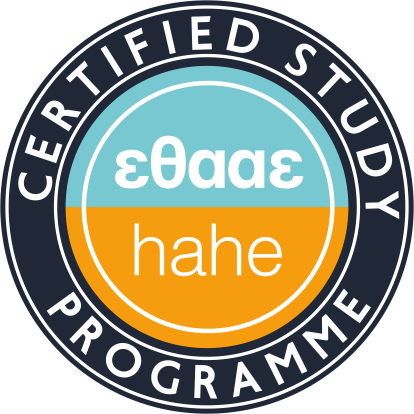Audiovisual Translation
Teaching Staff: Karantzi Ismini
Course Code: YE-9600
Gram-Web Code: ΓΠ1400
Course Category: Specific Background
Course Type: Compulsory Elective
Course Level: Undergraduate
Course Language: English / Greek
Semester: Any Spring
ECTS: 2
Total Hours: 2
Erasmus: Available (in English)
The aim of the module is to provide an introduction to Audiovisual Translation (AVT) and to familiarise students with this type of multimedia translation which poses various restrictions to translators and differs greatly from traditional interlingual translation. Dubbing, Audio Description, subtitling for the deaf and hard of hearing (SDH) are all covered, but emphasis is placed on interlingual subtitling which constitutes the prime type of AVT in Greece. Students use the free software Subtitle Edit, while other key subtitling programs are also introduced. Meanwhile, the students learn to work with the spatiotemporal and technical constraints of subtitling, the challenges posed by the various genres and those posed by the use of humour, slang and cultural-specific elements.
Upon completion of the course, students will be able to:
- understand the complex semiotic nature of audiovisual texts and analyze them for the purpose of subtitling
- identify the characteristics of the main types of AVT.
- understand the technical parameters of subtitling
- create subtitles with the help of special software (Subtitle Workshop) and use templates
- translate subtitles respecting spatiotemporal constraints and genre conventions.
- effectively address challenges related to the translation of dialects, verbal humor, and cultural indicators, by applying appropriate theories. In particular, they will be able to choose the most appropriate techniques and justify their translation options.
- understand the needs of people with disabilities and the AVT types that provide accessibility to culture and the media.
Week 1: Introduction to Audiovisual Translation. Types of AVT and multimodality. Accessibility to culture and the media.
Week 2: Interlingual subtitling: special features. Spatiotemporal constraints.
Week 3: Technical parameters of subtitling: timing and condensation of text. Introduction to the Subtitle Workshop subtitling software.
Week 4: Technical subtitling parameters: guidelines of presentation, formatting and punctuation. Further familiarity with the Subtitle Edit subtitling software.
Week 5: The template and its revolutionary effect on subtitling. Translation of subtitles from a template: from theory to practice.
Week 6: Translation and linguistic diversity: geographical dialects, social dialects, slang, idiolect.
Week 7: LSP and subtitling: challenges and strategies to effectively address them. Hands-on-session (subtitling of a judicial drama, a medical drama, a documentary about Leonardo da Vinci).
Week 8: Translation of cultural indicators/culture-specific items. Hands-on-session (subtitling of a Greek dramatic film).
Week 9: Translating Verbal Humor. Strategies to address the problems that arise and hands-on-session (subtitling of a British comedy)
Week 10: Introduction to dubbing: key features and challenges. Analysis of a dubbed children's film in Greek.
Week 11: Subtitling hands-on-session. Group work.
Week 12: The profession of the subtitler and the AVT industry in Greece and abroad. Opportunities and challenges. Reference to technology and machine translation.
Suggested Reading
In Greek:
Γεωργακοπούλου Α. – Γούτσος Δ. 1999. Κείμενο και επικοινωνία. Αθήνα: Ελληνικά Γράμματα.
Γκράμσι, Α., Λογοτεχνία και Εθνική Ζωή, Στοχαστής, Αθήνα, 1981.
Γουλέτη, Κ., “Tranlating Culture-Specific References on Greek Television: A diachronic
case study of subtitling trends”, Διδακτορική Διατριβή στο ΑΠΘ, Σεπτέμβρης 2012.
Γουλέτη, Κ., Πραγματολογική Ισοδυναμία στον Υποτιτλισμό: Αντιμετώπιση ιδιοπολιτισμικών Εννοιών, 1η Συνάντηση Νέων Μεταφρασεολόγων, 1-3 Νοέμβρη 2006, Αριστοτέλειο Πανεπιστήμιο Θεσσαλονίκης.
Δοξιάδης, Κ., Ανάλυση Λόγου: Κοινωνικο – φιλοσοφική θεμελίωση, Αθήνα, Πλέθρον, 2008.
Ζαμπέλη Κ., Οπτικοακουστική μετάφραση και υποτιτλισμός, Η περίπτωση των φεστιβάλ κινηματογράφου στην Ελλάδα, Μεταπτυχιακή Διπλωματική Εργασία, Ιόνιο Πανεπιστήμιο - ΤΞΓΜΔ, Κέρκυρα, 2011.
Κεντρωτής, Γ., Θεωρία και πράξη της μετάφρασης, Αθήνα, Δίαυλος, 1996.
Κωστοπούλου, Λ., Οι μεταφραστικές δυσκολίες στον υποτιτλισμό κινηματογραφικών ταινιών, 1η Συνάντηση Ελληνόφωνων Μεταφρασεολόγων, ΑΠΘ, 1-3 Νοεμβρίου 2006.
Κωστοπούλου, Λ., “Η αποτύπωση του χιούμορ στις ταινίες κινουμένων σχεδίων: ανάλυση μεταφραστικών τεχνικών”, 2η Συνάντηση Εργασίας Ελληνόφωνων Μεταφρασεολόγων, ΑΠΘ, 7-9 Μαΐου 2009.
Λαζαράτος, Γ., Umberto Eco: Διασημειωτική Μετάφραση & Μετάφραση και Επιστημολογία, Αθήνα, Παπαζήσης, 2007.
Metz, Ch., (2007), Ψυχανάλυση και κινηματογράφος: Το φαντασιακό σημαίνον, μτφ: Β. Πατσογιάννης, Φ. Σιατίτσας, Αθήνα, Πλέθρον, 2007.
Νανοπούλου, Δ., Μπαμπινιώτη, Γ., Από την κοσμογονία στη γλωσσογονία. Μια συν-
ζήτηση, Καστανιώτης, Αθηνα, 2010.
Παπασημακοπούλου, Θ., Ο οπτικός πολιτισμός μέσα από τη σημειολογία της έντυπης διαφήμισης, Πάντειο Πανεπιστήμιο, Αθήνα, 2007
Σόκολη, Σ., Υποτιτλιστικές νόρμες στην Ελλάδα και στην Ισπανία, 1η Συνάντηση Νέων Μεταφρασεολόγων, 1-3 Νοέμβρη 2006, Αριστοτέλειο Πανεπιστήμιο Θεσσαλονίκης.
In English, Spanish and other languages
Abend-David, D. (ed.) (2014) Media and Translation. An Interdisciplinary Approach. London and New York: Bloomsbury.
Araújo, V. (2004) “To be or not to be natural: clichés of emotion in screen translation”. Meta 49(1): 161-171.
Asimakoulas, D. (2004) “Towards a Model of Describing Humour Translation. A Case Study of the Greek Subtitled Versions of Airplane! and Naked Gun.” Meta 49(4): 822-842.
Bernal Merino, M. Á. (2002). La traducción audiovisual. Alicante: Universidad de Alicante.
Bogucki, L. (2004) “The constraint of relevance in subtitling”. The Journal of Specialised Translation 1. http://www.jostrans.org/issue01/articles/boguckien.htm [last accessed 22 August 2016].
Carroll, M. (2004) “Subtitling: changing standards for new media”. Lisa XIII, 3.3.
www.lisa.org/archive_domain/newsletters/2004/3.3/carroll.html
Chaume, F. (2012) Audiovisual Translation: Dubbing. Manchester: St Jerome Publishing.
Desilla, L. (2014) “Reading between the lines, seeing beyond the images: An empirical study on the comprehension of implicit film dialogue meaning across cultures”. The Translator 20(2): 194-214.
Díaz Cintas, J. & A. Remael (2007) Audiovisual Translation: Subtitling. Manchester: St. Jerome Publishing.
Díaz-Cintas, J., P. Orero and A. Remael (eds) (2007) Media for All: Subtitling for the Deaf, Audio Description and Sign Language. Amsterdam: Rodopi.
Fryer, L. An Introduction to Audio Description: A Practical Guide. London & New York: Routledge.
Georgakopoulou P. (2012). “Challenges for the audiovisual industry in the digital age: the ever-changing needs of subtitle production”, The Journal of Specialised Translation, Issue 17, January 2012, pp. 78-103 http://www.jostrans.org/issue17/art_georgakopoulou.pdf [last accessed 12 August 2016]
Georgakopoulou P. (2008). “Subtitling for the DVD Industry”, in J Díaz-Cintas & G Anderman (eds) Audiovisual Translation: Language Transfer on Screen, London: Palgrave Macmillan, pp. 21-35.
Karamitroglou, F. (2000) Towards a Methodology for the Investigation of Norms in Audiovisual Translation. Amsterdam: Rodopi.
Λαζαράτος, Γ. (2007) Umberto Eco: Διασημειωτική Μετάφραση & Μετάφραση και Επιστημολογία. Αθήνα, Παπαζήσης.
Neves, J. (2009) “Interlingual subtitling for the deaf and the hard-of-hearing”. In J. Díaz-Cintas and G. Anderman (eds) Audiovisual Translation: Language Transfer on Screen. Basingstoke: Palgrave Macmillan, 151-169.
Pérez-González, L. (2014) Audiovisual Translation. Theories, Methods and Issues. London and New York: Routledge.
Pettit, Zoe. 2005. "Translating register, style and tone in dubbing and subtitling" JoSTrans 4: 49- 65. http://www.jostrans.org/issue04/art_pettit.php [last accessed 12 August 2016].
Ramière, N. (2006) “Reaching a foreign audience: cultural transfers in audiovisual translation", JoSTrans 6: 152-166. Available at: http://www.jostrans.org/issue06/art_ramiere.php [last accessed 12 August 2016].
Σόκολη, Σ., (2006) “Υποτιτλιστικές νόρμες στην Ελλάδα και στην Ισπανία”, 1η Συνάντηση Νέων Μεταφρασεολόγων, 1-3 Νοέμβρη 2006, Αριστοτέλειο Πανεπιστήμιο Θεσσαλονίκης.
Σωσώνη, Β. & Καραντζή, Ι. (2016) “Η Οπτικοακουστική Μετάφραση και η προσβασιμότητα στο οπτικοακουστικό υλικό ατόμων με αναπηρία: Υποτιτλισμός για κωφούς και βαρήκοους και ακουστική περιγραφή”. http://blog.peempip.gr/audiovisual-translation/ [last accessed 12 July 2016].
Σωσώνη, Β. (2014) “Από την πρώτη Talkie στη Μηχανική Μετάφραση: Οπτικοακουστική Μετάφραση και Τεχνολογικές Εξελίξεις ”. Dictio 2014.
Zabalbeascoa, P. (2008) ‘The nature of the audiovisual text and its parameters’. In J. Díaz-Cintas (ed.) The Didactics of Audiovisual Translation. Amsterdam and Philadelphia: John Benjamins, 21-37.
The lesson has a hybrid lecture-workshop format. It is largely based on the interaction with students and classroom discussion. Hands-on-sessions focus on practical aspects of the issues covered and described during the lectures. The use of video material is complemented with the use of technology (i.e. Subtitle Edit) and in-class group work (translation and comments on subtitling). The class material is made available on the e-class platform.
Several ICT tools are used, mainly ppt presentations, online videos and Internet resources, as well as subtitling software. The class material is made available on the Open e-class platform.
A final written assignment is used to assess the students. It consists of subtitle translation and commentary on the translation problems faced and the strategies used to resolve them, backed by the theory taught during the semester.
Back
Undergraduate
Secretariat
Galinos Building (1st floor)
Corfu, GR-49132
Open to the public:
Mon, Wed, Fri: 11am - 1pm
Tue, Thu: 11am - 1pm (Erasmus+)
 E-Class Platform
E-Class Platform
 eSecretariat
eSecretariat
 Webmail
Webmail
 Learning Material Management
Learning Material Management
 Internship Portal
Internship Portal
 Library
Library





 Audiovisual Translation
Audiovisual Translation
